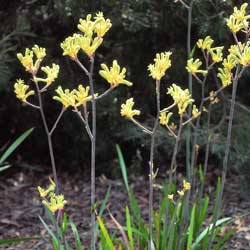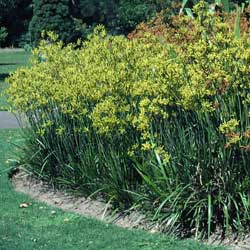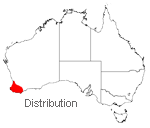Anigozanthos flavidus
 |
 |
Tall Kangaroo Paw
Anigozanthos flavidus DC. (1807)
Anigozanthos flavidus, commonly known as the evergreen kangaroo paw or the tall kangaroo paw, is from the family Haemodoraceae. This family, of 14 genera and 103 species, includes two genera of kangaroo paws. Macropidia consists of only one species, Macropidia fuliginosa (black kangaroo paw) whereas Anigozanthos consists of eleven species, including A. flavidus.
 All kangaroo paws are native to Western Australia, and only occur in the wild in this state. Anigozanthos flavidus occurs in the extreme south west of Western Australia, growing from Augusta east to Two Peoples Bay and north to Waroona. It can be found on roadsides, river banks, swamps, shallow water and in eucalypt forests, tolerating light shade.
All kangaroo paws are native to Western Australia, and only occur in the wild in this state. Anigozanthos flavidus occurs in the extreme south west of Western Australia, growing from Augusta east to Two Peoples Bay and north to Waroona. It can be found on roadsides, river banks, swamps, shallow water and in eucalypt forests, tolerating light shade.
Anigozanthos flavidus is a perennial herb, with evergreen leaves growing up to one metre long and two centimetres wide, forming clumps up to two metres across. It forms a rhizome, or modified stem underground, which grows to five centimetres in diameter. This rhizome makes the plant resistant to fire and drought, as it is able to re-sprout once conditions improve.
Flowering occurs from November to February, creating a colourful summer display when little else in the garden flowers. The inflorescence is produced on a flowering scape from the centre of the leaf fan. One plant may produce up to ten stems, with total flower production reaching up to 350 per plant. The flowers are covered in velvety hairs, which may become irritating if in constant contact with skin and eyes. The flowers are commonly green and yellow, but also occur in red, pink and orange. The flowers are stunning in both fresh and dried flower arrangements.
Flowers are bird pollinated. The bird pushes its beak into the tubular perianth to reach the nectar and in doing so brushes its head against the stamens which deposit the pollen. This pollen is then transferred onto the next flower the bird visits. Planting A. flavidus in the garden will encourage native bird activity.
Anigozanthos flavidus is easy to grow from both seed and rhizome cuttings, and is considered the easiest of all kangaroo paws to grow. Seed can be collected from March – April and sown in a sandy seed raising mix. Germination will occur in 15-40 days after the first watering.
Rhizome divisions can be taken in March – May, simply by cutting the rhizome with a sharp knife or spade, ensuring each section has a healthy bud on it. These can then be planted as separate plants and will recover very quickly.
Anigozanthos flavidus is adaptable to most soil types, from sandy to clay, and will even grow partly immersed, tolerating wet feet. It is less prone to the fungal attacks other kangaroo paws suffer, such as ink spot disease or rust. If it does develop ink spot disease, obvious by black spots on the leaf caused by the various strains of the fungus Alternaria alternata, the leaves can be cut down to ground level with removed material disposed of. The plant is very hardy and tolerant and will recover well from this treatment. To avoid further outbreaks of ink spot disease simply avoid overhead watering of the plant, keeping the leaves dry.
The only other problem A. flavidus may suffer from is snails. However, it is much more resistant to these than other species of kangaroo paw and will mostly only suffer snail attack as seedlings.
Overall, Anigozanthos flavidus is a very hardy, tough Australian native plant, with records of it lasting over 30 years in the garden. It is adaptable, extremely tolerant, and does well both in the garden and in pots on the balcony, as long as it is sheltered from frost.
Text by Melita Baum (2006 Student Botanical Intern)
Photos by M.Fagg; (top ANBG, below Royal Botanic Gardens, Melbourne)
Name meaning: Anigozanthos flavidusAnigozanthos - from the Greek anises, meaning unequal, and anthos, meaning flower, referring to the unequal perianth lobes of the flowers. flavidus - yellow, referring to the common yellow flowered form of the plant |
References
Hopper, S. D. (1979) Hybridising Anigozanthos. Australian Plants. 10:81, 211-217
Hopper, S. D. (1993). Kangaroo Paws and Catspaws. Department of Conservation and Land Management. Western Australia.
Society for Growing Australian Plants. (1991)Australian Plants, 16:126.
![An Australian Government Initiative [logo]](/images/austgovt_brown_90px.gif)

